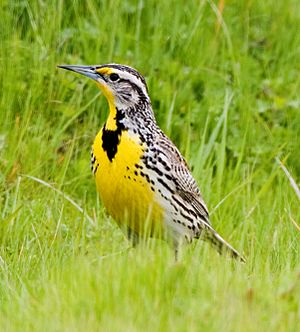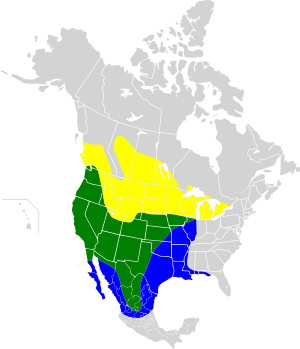Western meadowlark facts for kids
Quick facts for kids Western meadowlark |
|
|---|---|
 |
|
| Conservation status | |
| Scientific classification | |
 |
|
| Range of S. neglecta Breeding range Year-round range Wintering range |
The western meadowlark (scientific name: Sturnella neglecta) is a medium-sized bird. It belongs to the icterid family, which includes orioles and blackbirds. This bird is about 22 centimeters (8.5 inches) long.
Western meadowlarks build their nests on the ground. They live in open grasslands across western and central North America. They mostly eat insects, but also enjoy seeds and berries. These birds have special calls that sound like water or a flute. This helps tell them apart from their close relative, the eastern meadowlark. The western meadowlark is the official state bird for six states: Montana, Kansas, Nebraska, North Dakota, Oregon, and Wyoming.
Contents
What's in a Name?
The western meadowlark was officially named in 1844. An American bird expert named John James Audubon gave it its current scientific name, Sturnella neglecta. The word neglecta comes from Latin and means "ignored" or "overlooked."
Audubon explained that explorers Lewis and Clark had seen yellow larks in 1803-1806. But no one had officially described them yet. The first place this bird was found and described was at Old Fort Union in North Dakota.
There are two main types, or subspecies, of western meadowlarks:
- S. n. neglecta: Found from southwest and south-central Canada, through the western USA (but not the Pacific Northwest coast), down to central Mexico.
- S. n. confluenta: Lives along the coast of southwest Canada and the northwest USA (from southwest British Columbia to Oregon).
Sometimes, western meadowlarks and eastern meadowlarks breed together where their homes overlap. However, their young birds often have trouble having their own babies.
How to Spot a Western Meadowlark
Adult western meadowlarks have bright yellow feathers on their bellies. They have a black "V" shape on their chest. Their sides are white with black stripes. Their backs are mostly brown with black streaks.
These birds have long, pointy beaks. Their heads have stripes of light brown and black bands.
Measurements:
- Length: 16-26 cm (6.3-10.2 inches)
- Weight: 89-115 grams (3.1-4.1 ounces)
- Wingspan: 41 cm (16.1 inches)
Western meadowlarks are known for their beautiful, flute-like, warbled song. This song is different from the simpler, whistled call of the eastern meadowlark.
Where They Live
Western meadowlarks live in grasslands, prairies, pastures, and old fields. You can find them across western and central North America, reaching as far south as northern Mexico.
Where western and eastern meadowlarks live in the same areas, western meadowlarks prefer drier, thinner plants. The two types of birds usually don't breed together, but they do defend their territories from each other.
Their nests are built on the ground and have a roof made of woven grass. A male meadowlark might have more than one female nesting in his area. Sometimes, nests with eggs or young birds are accidentally destroyed when fields are mowed.
Many western meadowlarks stay in the same place all year. Birds from the northern parts of their range might migrate to warmer southern areas for winter. Some also move east in the southern United States.
Life Cycle and Habits
Reproduction
The female western meadowlark builds her nest soon after she arrives at the breeding grounds. She places the nest in a hidden spot on the ground. The nest can look different each time. It might be a simple cup or a covered structure with a little path leading to the entrance.
She lays one egg each day. The female starts sitting on the eggs only after the last one is laid. The eggs are about 28 by 21 millimeters (1.1 by 0.8 inches). They are white with brownish spots and blotches.
The eggs hatch over one or two days after the female has kept them warm for 13–15 days. The baby birds, called chicks, are born helpless and almost naked. Their eyes stay closed until they are about four days old. Only the female bird keeps the chicks warm.
The nestlings eat mostly insects. The male bird brings food to the nest, but the female usually feeds it to the chicks. The young birds leave the nest when they are 10-12 days old. However, they can only fly well when they are about 21 days old. The parents continue to care for them for about two weeks after they leave the nest. Western meadowlarks often try to raise a second group of babies in the same year.
Sometimes, brown-headed cowbirds (Molothrus ater) lay their eggs in western meadowlark nests. The cowbird chicks then get raised by the meadowlark parents.
Food and Feeding
These birds look for food on the ground or in low plants. They sometimes use their beaks to poke around for food. They mainly eat insects. But they also enjoy eating seeds and berries. In winter, western meadowlarks often feed together in large groups.
Western Meadowlarks and People
The western meadowlark is the official state bird of six states: Montana, Kansas, Nebraska, North Dakota, Oregon, and Wyoming. Only the northern cardinal is the state bird for more states (seven states).
In 2017, there was a small debate in Oregon about their state bird. Some people thought the osprey should be the state bird instead of the western meadowlark. The discussion got quite lively! One lawmaker even played the meadowlark's song on his phone over the microphone in the House.
They finally agreed on a compromise. The western meadowlark was named the state songbird. The osprey was named the state raptor (a bird of prey).
See also
 In Spanish: Turpial gorjeador para niños
In Spanish: Turpial gorjeador para niños



